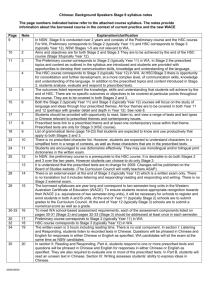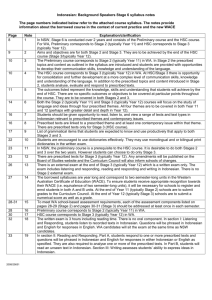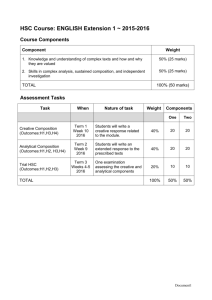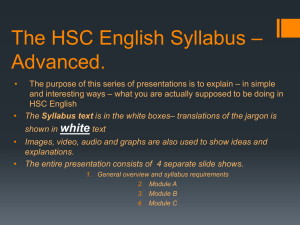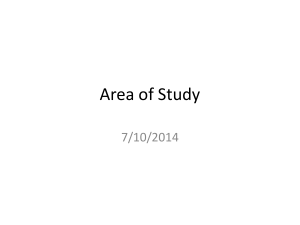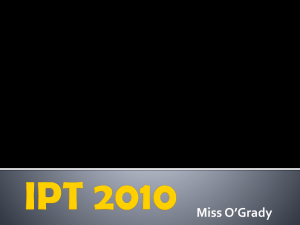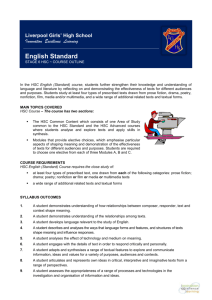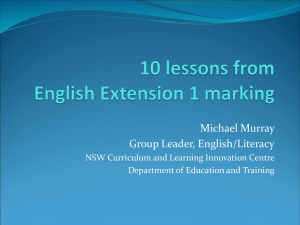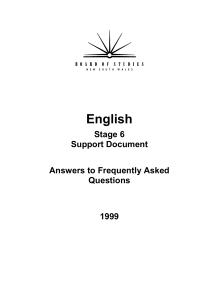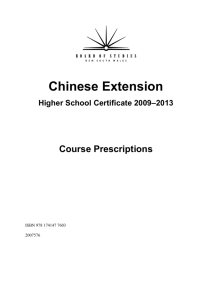48 Kb
advertisement
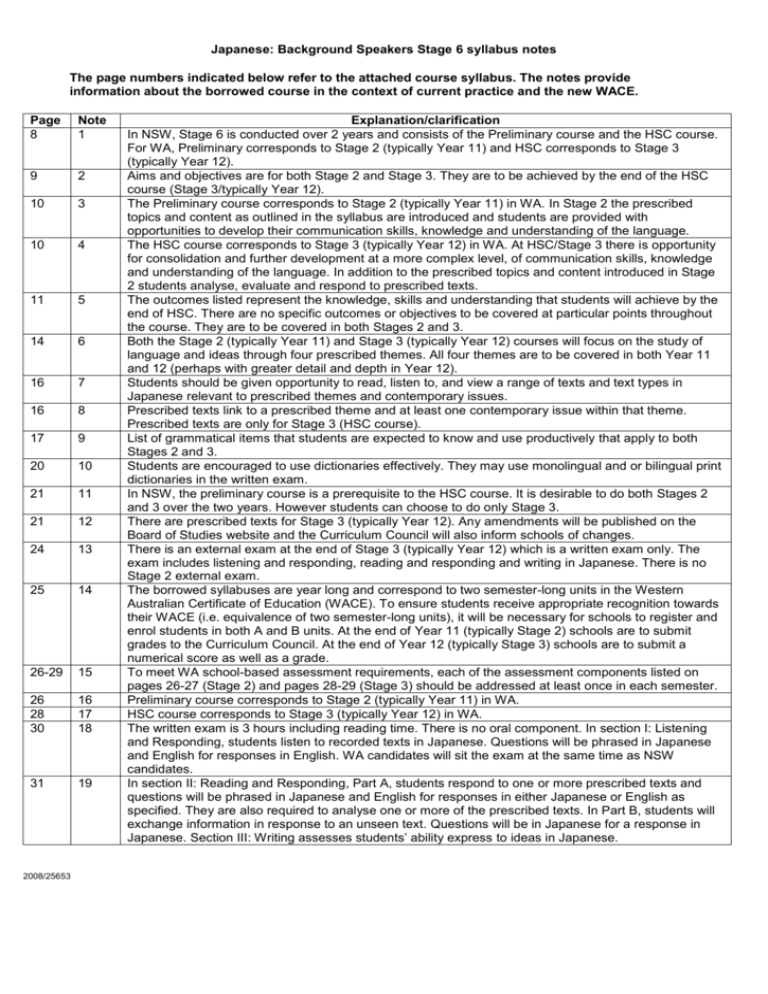
Japanese: Background Speakers Stage 6 syllabus notes The page numbers indicated below refer to the attached course syllabus. The notes provide information about the borrowed course in the context of current practice and the new WACE. Page 8 Note 1 9 2 10 3 10 4 11 5 14 6 16 7 16 8 17 9 20 10 21 11 21 12 24 13 25 14 26-29 15 26 28 30 16 17 18 31 19 2008/25653 Explanation/clarification In NSW, Stage 6 is conducted over 2 years and consists of the Preliminary course and the HSC course. For WA, Preliminary corresponds to Stage 2 (typically Year 11) and HSC corresponds to Stage 3 (typically Year 12). Aims and objectives are for both Stage 2 and Stage 3. They are to be achieved by the end of the HSC course (Stage 3/typically Year 12). The Preliminary course corresponds to Stage 2 (typically Year 11) in WA. In Stage 2 the prescribed topics and content as outlined in the syllabus are introduced and students are provided with opportunities to develop their communication skills, knowledge and understanding of the language. The HSC course corresponds to Stage 3 (typically Year 12) in WA. At HSC/Stage 3 there is opportunity for consolidation and further development at a more complex level, of communication skills, knowledge and understanding of the language. In addition to the prescribed topics and content introduced in Stage 2 students analyse, evaluate and respond to prescribed texts. The outcomes listed represent the knowledge, skills and understanding that students will achieve by the end of HSC. There are no specific outcomes or objectives to be covered at particular points throughout the course. They are to be covered in both Stages 2 and 3. Both the Stage 2 (typically Year 11) and Stage 3 (typically Year 12) courses will focus on the study of language and ideas through four prescribed themes. All four themes are to be covered in both Year 11 and 12 (perhaps with greater detail and depth in Year 12). Students should be given opportunity to read, listen to, and view a range of texts and text types in Japanese relevant to prescribed themes and contemporary issues. Prescribed texts link to a prescribed theme and at least one contemporary issue within that theme. Prescribed texts are only for Stage 3 (HSC course). List of grammatical items that students are expected to know and use productively that apply to both Stages 2 and 3. Students are encouraged to use dictionaries effectively. They may use monolingual and or bilingual print dictionaries in the written exam. In NSW, the preliminary course is a prerequisite to the HSC course. It is desirable to do both Stages 2 and 3 over the two years. However students can choose to do only Stage 3. There are prescribed texts for Stage 3 (typically Year 12). Any amendments will be published on the Board of Studies website and the Curriculum Council will also inform schools of changes. There is an external exam at the end of Stage 3 (typically Year 12) which is a written exam only. The exam includes listening and responding, reading and responding and writing in Japanese. There is no Stage 2 external exam. The borrowed syllabuses are year long and correspond to two semester-long units in the Western Australian Certificate of Education (WACE). To ensure students receive appropriate recognition towards their WACE (i.e. equivalence of two semester-long units), it will be necessary for schools to register and enrol students in both A and B units. At the end of Year 11 (typically Stage 2) schools are to submit grades to the Curriculum Council. At the end of Year 12 (typically Stage 3) schools are to submit a numerical score as well as a grade. To meet WA school-based assessment requirements, each of the assessment components listed on pages 26-27 (Stage 2) and pages 28-29 (Stage 3) should be addressed at least once in each semester. Preliminary course corresponds to Stage 2 (typically Year 11) in WA. HSC course corresponds to Stage 3 (typically Year 12) in WA. The written exam is 3 hours including reading time. There is no oral component. In section I: Listening and Responding, students listen to recorded texts in Japanese. Questions will be phrased in Japanese and English for responses in English. WA candidates will sit the exam at the same time as NSW candidates. In section II: Reading and Responding, Part A, students respond to one or more prescribed texts and questions will be phrased in Japanese and English for responses in either Japanese or English as specified. They are also required to analyse one or more of the prescribed texts. In Part B, students will exchange information in response to an unseen text. Questions will be in Japanese for a response in Japanese. Section III: Writing assesses students’ ability express to ideas in Japanese.

